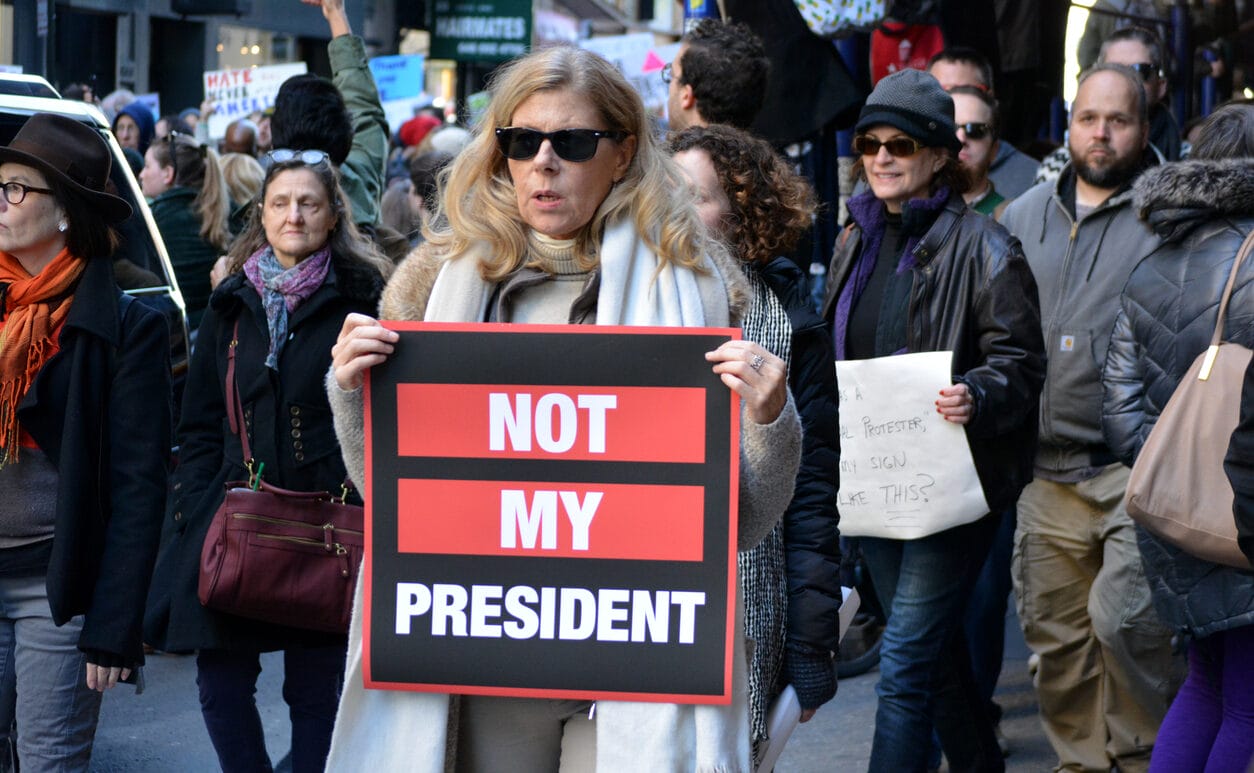Five bygone elections that echo into 2024

“The ugliest presidential election in history!”
“The biggest election of our lifetime!”
“The most dangerous candidate ever.”
Another quadrennial brings another round of the same hyperbole. Who’s to say none of them apply to 2024? But an honest look at past elections suggests that there is nothing new under the sun.
More than once, a celebrity candidate ran as a man of the people – and his opponent portrayed him as a dangerous demagogue. More than once, a party tried to swap out its candidate and change horses midstream. More than once, the legitimacy of the previous election became a major issue. More than once, a presidential candidate was portrayed as a sexual predator. More than once, presidential hopefuls were the targets of assassins. More than once, the rhetoric suggested our nation was reaching its end – though on one occasion, it was very nearly true. More than once, the press was there to pour oil on the fire.
Several notable presidential elections offer comfort that we’ve been here before for those who would otherwise see the current race as a sign of the end times. There are also warnings, however, for those who assume that our republic is unbreakable.
Founding Fathers Street Fight
Nearly a quarter-century had passed since John Adams sat at Thomas Jefferson’s elbow as he drafted the Declaration of Independence. At that time, both served as leaders in the Second Continental Congress, in diplomatic posts, in George Washington’s administration, with Adams as vice president and Jefferson as secretary of state.
But their ideological paths had diverged. The two Founding Fathers were pitted against each other in the election to succeed Washington in 1796. Adams took the first round. By the rematch of 1800, it was all-out party warfare between Adams’ Federalists and Jefferson’s Democratic Republicans.
Two Congressmen came to fisticuffs in session. There were brawls in the streets between the two political factions. To the Federalists, a Jefferson victory would mean a violent French-style revolution. To the Republicans, an Adams victory would mean tyranny. “Men who have been intimate all their lives,” Jefferson observed, now “cross the streets to avoid meeting and turn their heads another way, lest they should be obliged to touch their hats.”

The Federalists passed the Alien and Sedition Acts and weaponized the latter to convict Republicans who spoke or printed the wrong words. Not that the Republicans minced words. One notable called Adams a “hideous hermaphroditical character,” among other colorful epithets. The Federalist press branded the Republicans as “Jacobins,” and Jefferson as an atheist, a libertine and a weakling, among other insults. They accused him of colluding with the French to Jacobinize America.
The Hamiltonian wing of the Federalists, deeming Adams to be “unfit,” moved to replace him midstream as the candidate, a bad sign for the party’s prospects. Jefferson ultimately won the election and called for Americans to “unite with one heart and one mind … We have called by different names brethren of the same principle. We are all republicans: we are all federalists.”
In fact, it was the beginning of the end for the Federalists. The Republicans went on to enjoy a quarter-century of one-party rule and an era of “good feelings.”
The Celebrity President
A quarter century later, a new era of faction was unfolding. The election of 1824 was the last time America saw a campaign in which all candidates were members of the party. Yet it turned out to be so controversial that it launched a new political party and the first so-called “populist” movement. Key features of the election echo down 200 years later: Andrew Jackson, the hero of the Battle of New Orleans, was a celebrity outsider candidate who positioned himself as the voice of the common folk against the elite but was perceived as a threat to the establishment. And at the center of it all were accusations of backroom dealings to install a preferred candidate as president.
The two leading contenders of 1824 – John Quincy Adams and Andrew Jackson – would have a rematch in 1828. In the first round, Jackson won pluralities in both the popular and electoral votes in a four-candidate field. But with no majority, the decision between the top candidates, Jackson and Adams, went to the House of Representatives.
Speaker of the House Henry Clay – himself a candidate in the field of 1824 – held the power to move votes sufficient to choose the next president. The obvious choice might have been Jackson, based on the numbers. But Clay saw Jackson as unqualified and a dangerous demagogue. He engineered an Adams victory – and then accepted an appointment as secretary of state from the newly elected Adams.
Jackson’s wrath awakened. He labeled Clay “the Judas of the West.” Terming Clay’s appointment a “corrupt bargain” and an “unholy alliance,” Jackson suggested the presidency was stolen. That became his rallying cry for 1828.
Forming what came to be known as the Democratic Party, Jackson unleashed a fighting machine. He whipped up patriotic fervor on the campaign trail and took electioneering to new heights with rallies, parades, and picnics.
Adams’ “National Republicans” painted Jackson as despotic and accused Jackson of adultery, murder, theft, and treason. They even went after the chastity of both Jackson’s wife and his mother. Jackson’s Democrats accused Adams of serving as pimp to the czar as U.S. minister to Russia.
But the voting franchise had been rapidly expanding. In 1828, over a million Americans voted, more than triple the number in 1824. Jackson won in a landslide.
Jackson set the pattern for celebrity candidates followed in varying degrees by Theodore Roosevelt, Ronald Reagan, and Donald Trump. Likewise, his ascendancy brought a redefinition and realignment of the political order.
Extreme Polarization
The Jackson years gave way to an era of musical chairs. Among the first seven presidents, all five not named Adams had been two-termers. But after Jackson, the U.S. would see another eight presidents without a single re-election. The next president to win two terms would do so under the direst circumstances.
In the post-Jackson years, the slavery issue presented an increasing challenge to national unity. But it was the Mexican War of the late 1840s that pushed the discord into high gear.
Opponents of slavery had portrayed the Mexican War as an evil enterprise fought to expand human bondage. Yet following the war it became clear the North was rapidly outstripping the South in economic and population growth, making states’ rights the South’s only perceived safeguard against Northern supremacy. As Northern opposition to the expansion of slavery became more articulate and pronounced, Southern justification became more emotional and ideological. And in both sections, an increasing cohort of politicians could secure election by invoking strident rhetoric. Congress became ineffective at reaching compromise.
The temperature kept rising. Abolitionist William Lloyd Garrison burned a copy of the Constitution in public, calling it “an agreement with Hell” and suggesting the breakup of the Union as a means of purifying the North from the irredeemable South. In 1856, Massachusetts Sen. Charles Sumner insulted a South Carolina senator for his pro-slavery stance. A Congressman from South Carolina defended his compatriot by appearing on the floor of the Senate with his cane and beating Sumner to a pulp.

The sectional disdain built to a crescendo of loathing in the fall of 1859. John Brown, a fanatic subsidized by abolitionists, sought to lead a slave revolt by seizing the Harpers Ferry arsenal in Virginia. Brown, along with some of his abolitionist brethren, had openly called for the murder of Southerners. Brown had himself carried out such homicides in Kansas.
His arrest and execution made him a martyr in the Northern press – which Southerners took as an endorsement of his methods. One-fourth of Southerners owned slaves and many Northerners remained sympathetic to the South, but by this point, such distinctions were hard to find in the newspapers. To make matters worse, the burden of tariffs fell on the South, and Lincoln campaigned on higher tariffs. Southerners perceived this as a transfer of their wealth from South to North. The “dissolution of the Union” was now openly discussed in the South.
When the election of 1860 came, the Democratic Party divided in two along sectional lines, and a fourth party emerged in response to the chaos, with the Constitutional Unionist Party forming around John Bell.
Lincoln won with less than 40% of the popular vote – but a majority of the Electoral College from a swath of Northern states. In the minds of many Southerners, this meant a choice between Northern hegemony over the South and secession. Some deplored secession and fought against it. But even those who opposed secession, like Robert E. Lee, “went with his state” once the die was cast.
Four years into the Civil War, Lincoln stood for re-election again. Lincoln had been tarred with every variety of insult, with “despot” being among the most common. The Democratic Party platform of 1864 called the war a “failure” and demanded “immediate efforts” toward “cessation of hostilities.” While their candidate, the Union Gen. George McClellan, rejected this peace plank, he did believe that Lincoln had become a puppet of the radical wing of the party. He believed that Lincoln’s re-election would usher in an era of heightened brutality toward the South.
Of course, Lincoln took the oath for a second term, and Lee soon surrendered to Gen. U.S. Grant at Appomattox Courthouse. Lincoln’s magnanimity toward the post-war South was never put to the test, as he was assassinated a few days thereafter.
Pulling a ‘Cleveland’
From 1860 to 1912, the Republicans enjoyed a long period of dominance interrupted (twice) by just one Democrat – Grover Cleveland. Cleveland is unique among presidents in accomplishing something Trump is now attempting: two non-consecutive terms.
In addition to Cleveland and Trump, only two other men have even attempted this feat – Martin Van Buren and Teddy Roosevelt – both unsuccessfully. (Interestingly, all four have been New Yorkers.)
There are other parallels between Trump and Cleveland. Cleveland was a self-styled enemy of the political machine in Washington, D.C., running in 1884 on a drain-the-swamp platform in one of the most acrimonious campaigns in presidential history. With solid support across the South, he was elected president despite strident attacks on him as a carousing womanizer and misgivings within his own party. His First Lady was decades younger and was famed for being stylish. In foreign affairs, he leaned toward a non-interventionist stance and an emphasis on national self-defense. After his first term, he was defeated amidst charges that voter fraud had benefited his opponent, Benjamin Harrison.
In 1892, he made another run at the presidency, beating the drums of election integrity. This time, Cleveland defeated the exhausted Harrison handily, with a third-party populist candidate winning several states in the West and Great Plains.
Today, as Trump attempts to pull a “Cleveland,” his chances are clearly better than those of Van Buren and Teddy Roosevelt (both of whom spoiled their former parties’ shots at victory by running under the banners of newly formed parties).
From Harmony to Dissonance
In 1960, 100 years past the point when the nation was most divided, the U.S. was at one of its very peaks of unity. The policy differences between the presidential contenders – Vice President Richard Nixon and Sen. John F. Kennedy – seemed trifling by today’s standards. The zeitgeist suggested optimism.

Eight years later, both President Kennedy and his brother had been assassinated, along with Martin Luther King. Cities were burning with race riots. The incumbent President Johnson had foregone a re-election bid. A deadly year in Vietnam brought campus protests, the anti-war movement, and the rise of the hippies. Recreational drug use and the sexual revolution were revving up. Divorce rates were escalating. Two-parent families were beginning a long decline.
The triumphal post-war era that peaked around 1960 had disintegrated at a shocking pace. World War II veterans must have been shaking their heads in disbelief. Could a change at the top restore confidence?
In this context, it was natural for Americans to look back to a prominent figure from the “good old days” of the Eisenhower era, opening the way for Nixon’s comeback on the Republican side. On the Democrats’ side, Bobby Kennedy similarly fit the bill, but his assassination in June 1968 instead made him for years thereafter a symbol of lost hope, a future that might have been. The Democrats nominated Vice President Hubert Humphrey of Minnesota. American Independent George Wallace (himself later the target of an assassination attempt) complicated matters with a Southern revolt against the Democrats.
Running on a law and order platform, Nixon narrowly prevailed with a plurality of the popular vote, but a decisive Electoral College win. Four years later, he was one of the most popular incumbents in history, defeating the left-lurching Democrat George McGovern by a massive 23% margin in the popular vote and winning 49 states.
But under the surface, social breakdown was continuing. And, not far into “Tricky Dick’s” second term, the Watergate scandal seemed to prove the old adage that history is just one damned thing after another.
Peter Reichard is chief development officer at the Sutherland Institute in Utah. He has served as a public policy organization executive and researcher for more than 20 years.



